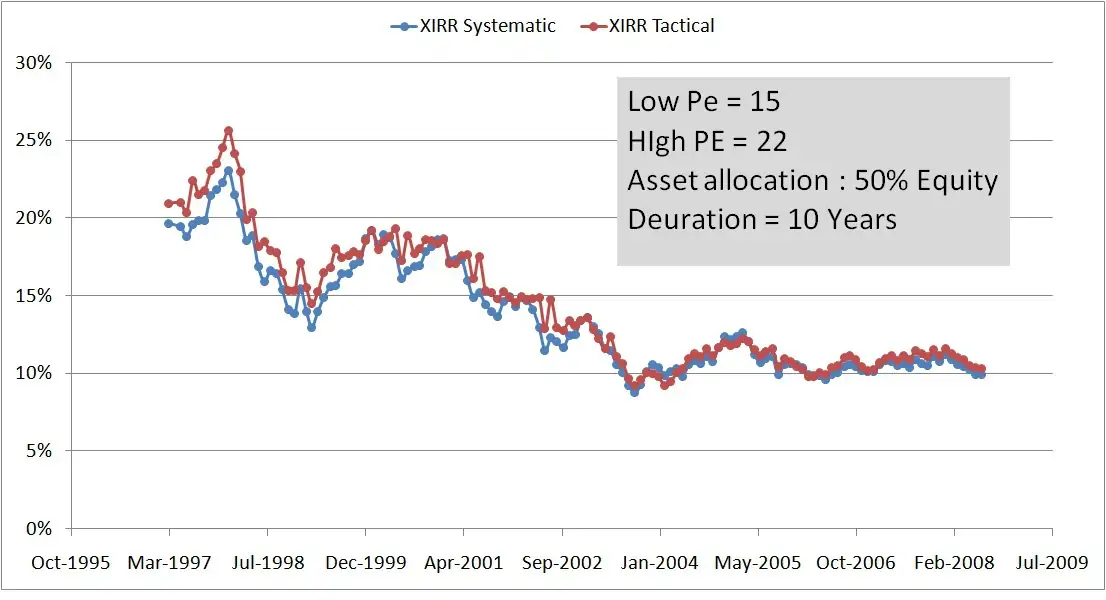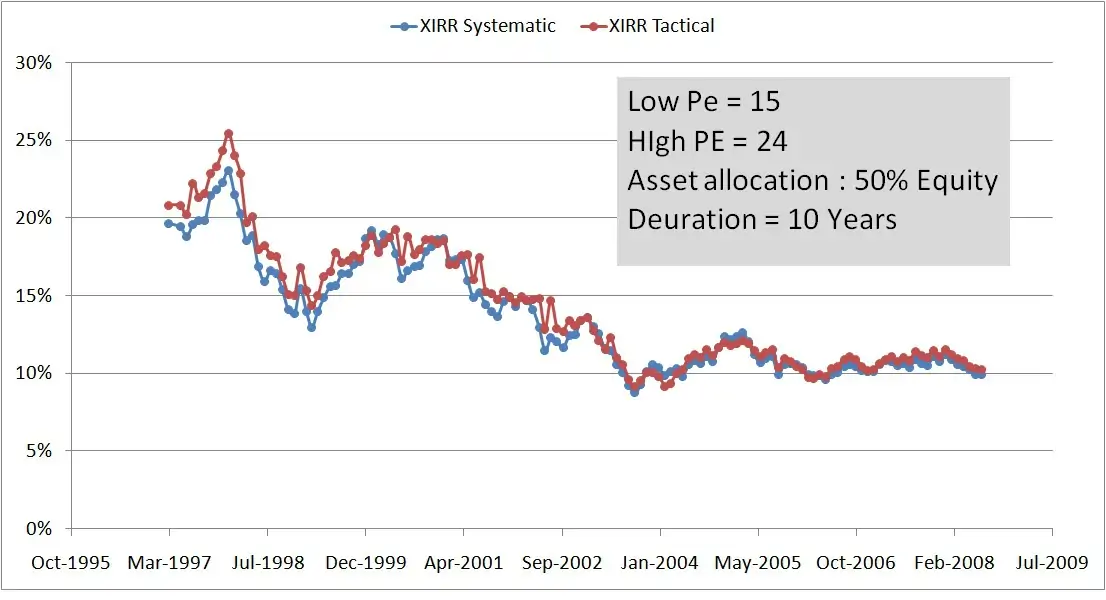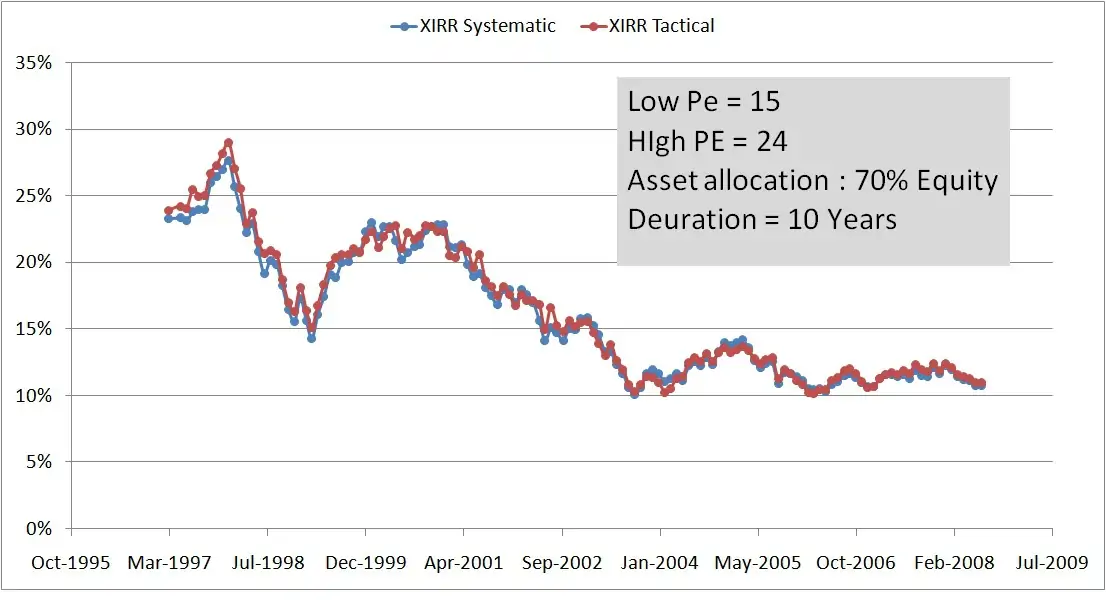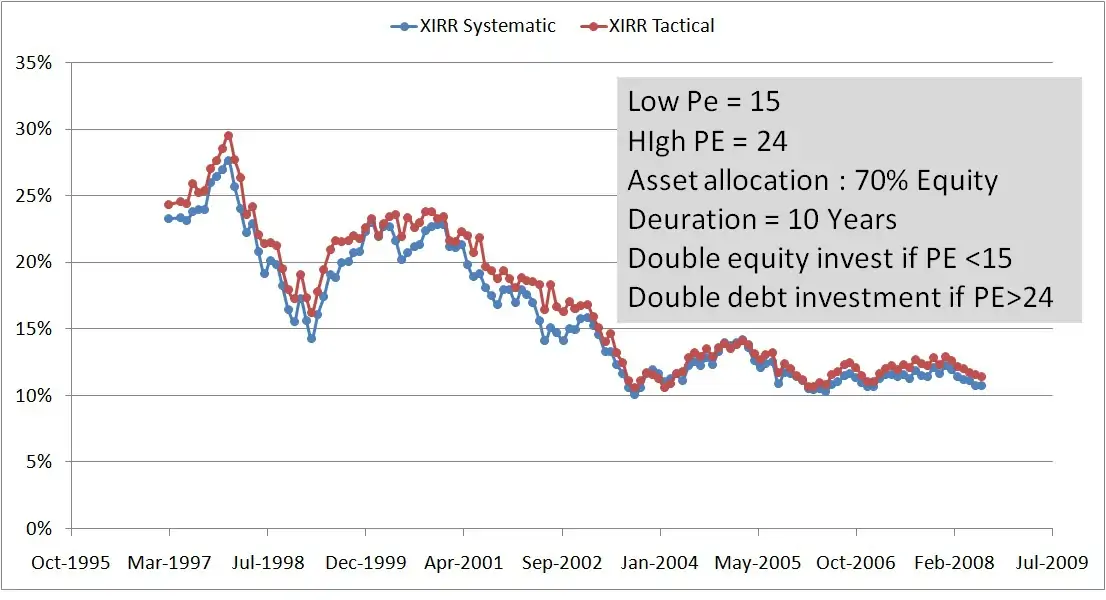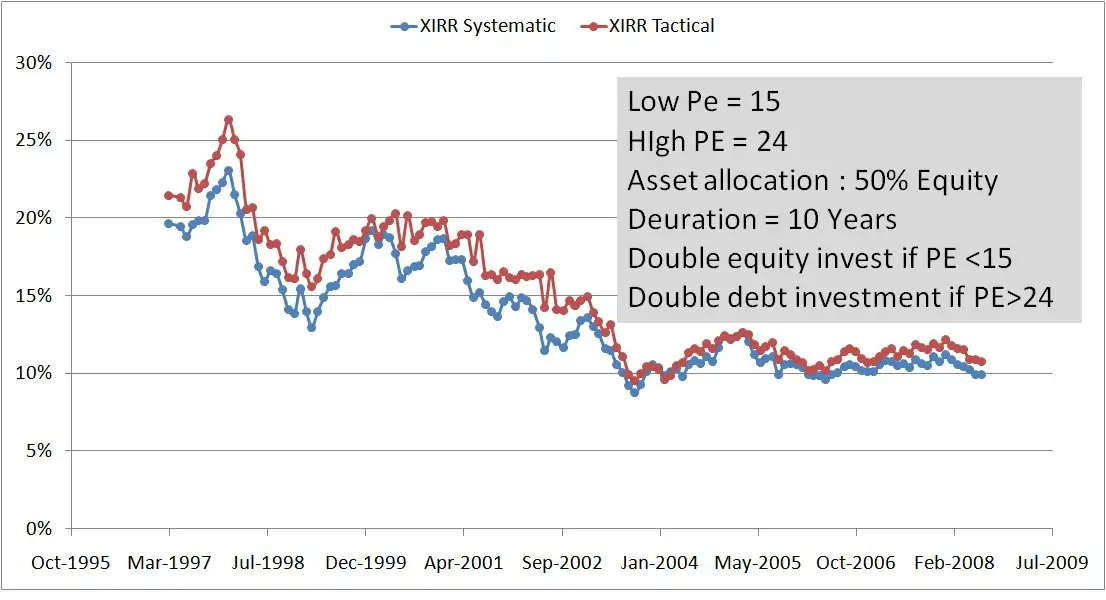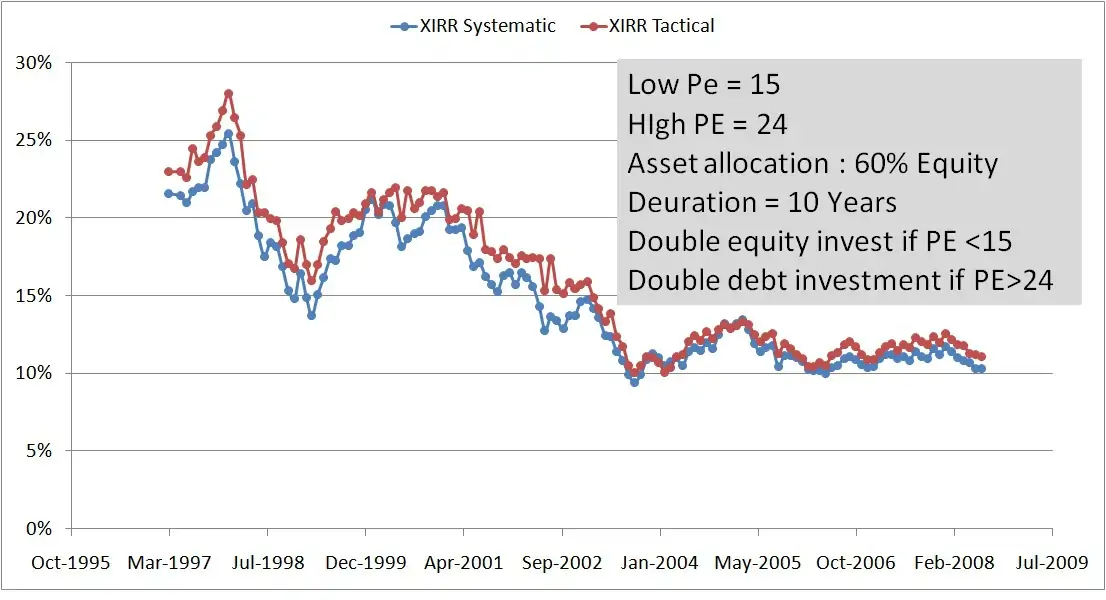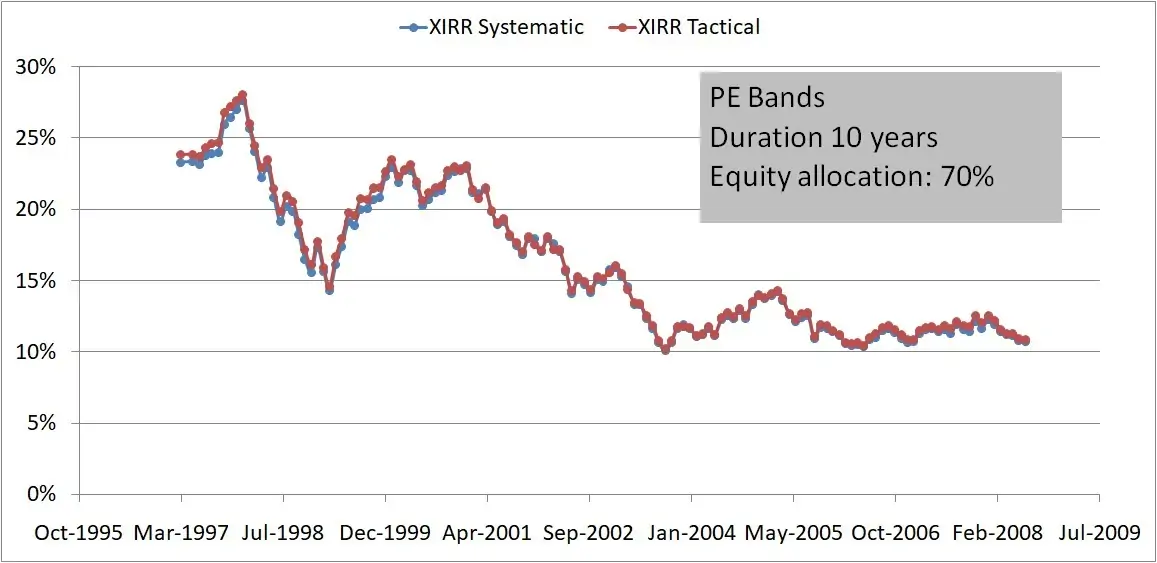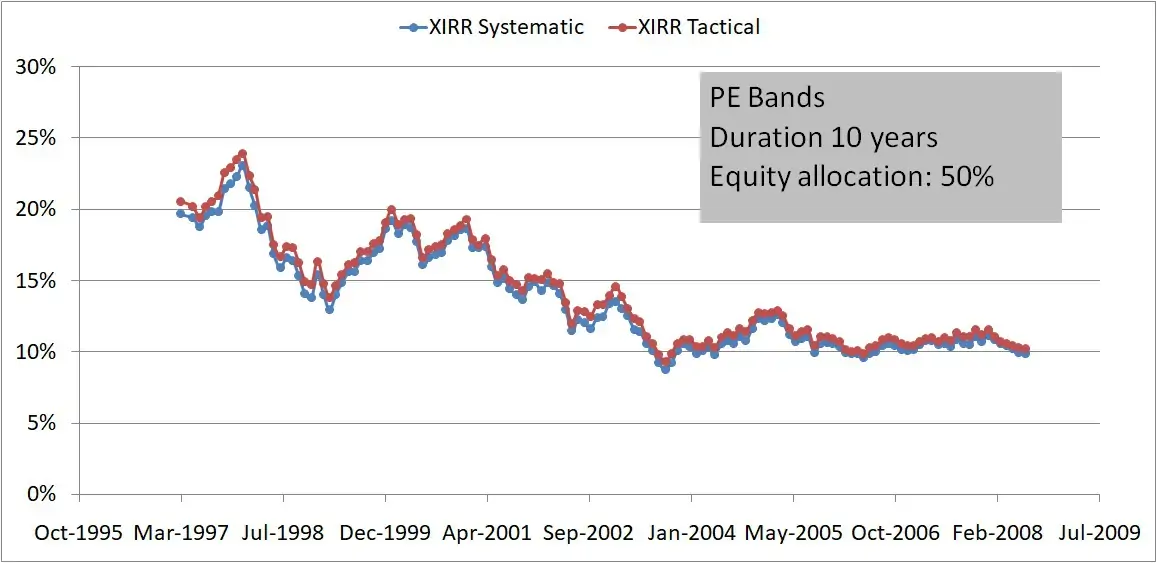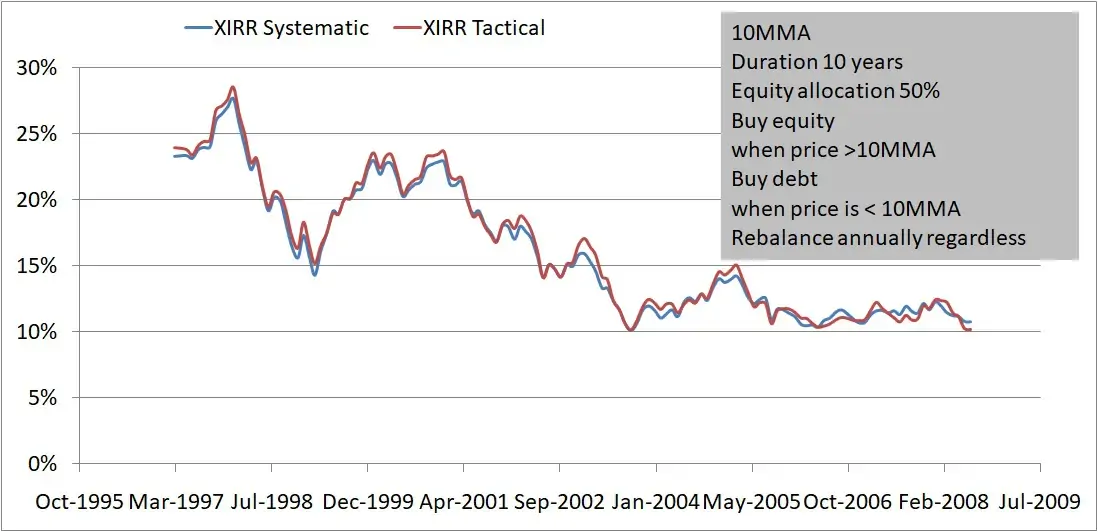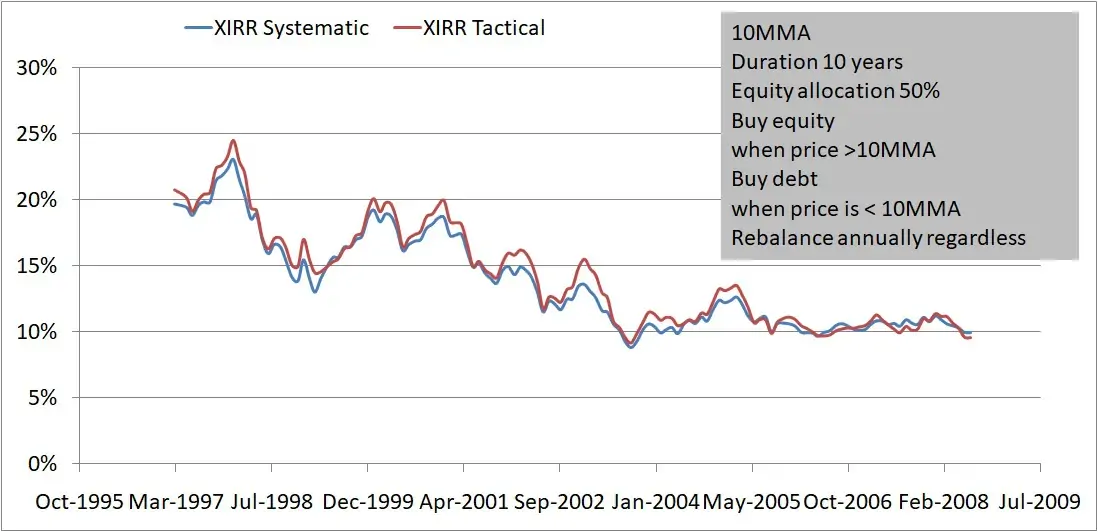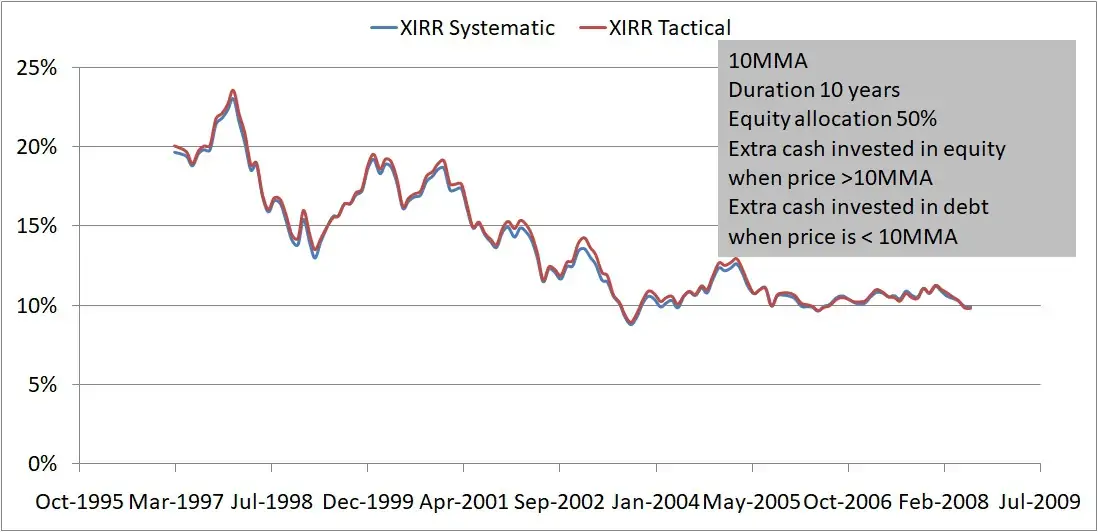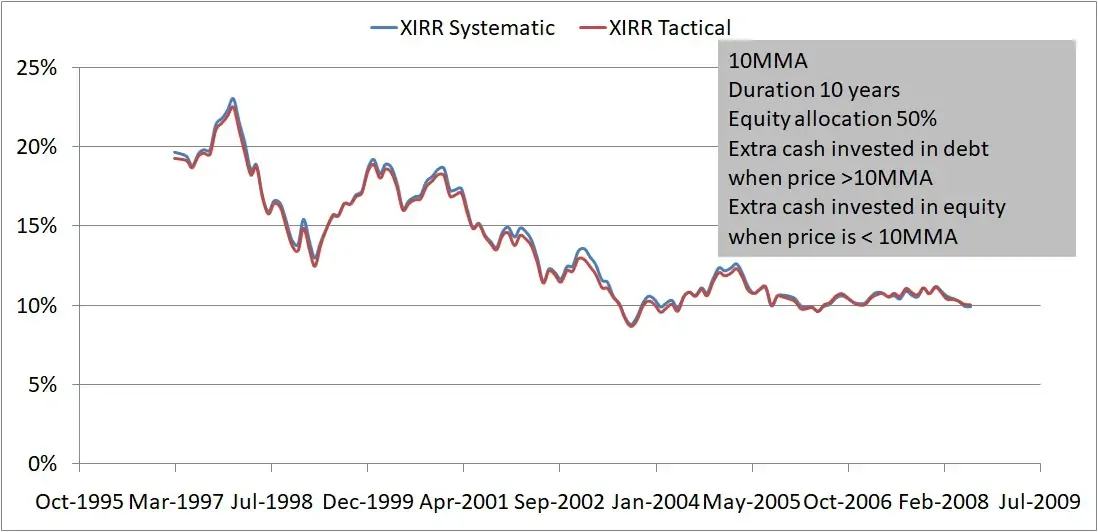Last Updated on December 28, 2021 at 6:49 pm
One thing is clear from this series on market timing. There is a lot of inertia when it comes to selling equity and moving to debt in the name of timing. Many seem to prefer “buying on dips”. That is whenever they “feel” there is a “buying opportunity”. So for the 4th part in this series, I focus on “buying only market timing”.
Announcement: I have started a “support site” for freefincal. This is for users fo freefincal tools to get updates and let me know if issues that they have. You can get email updates by subscribing over there. This is the first post: A list of instructions to be made by users of the freefincal automated mutual fund tracker. Please follow this to make it work after the SEBI fund changes. Let me know if you have any issues. If you want to download the latest excel mf tracker, you can get it from here: Automated Mutual Fund Performance Tracker
For example, suppose your idea of low PE = 19 and high PE = 24. We consider two ways (among many) of investing: A you buy only equity when PE < 19. You buy only debt when PE > 24 and in between you invest systematically as per a given asset allocation. B You buy twice as much of equity when PE < 19 and twice as much of debt when PE > 24 and in between as per asset allocation. Let us consider examples.
Example for A. Suppose your monthly investment amount = Rs. 1000 and your asset allocation is 60% equity and 40% debt (codename 60:40). Each month you check the PE. IF PE < 19, you invest Rs. 1000 in equity and none in debt. If PE > 24, you invest Rs. 1000 in debt and none in equity. If PE is between 19 and 24, you invest Rs. 600 in equity and Rs. 400 in debt. Once a year you rebalance the portfolio back to 60:40, unless the PE < 19.
Join 32,000+ readers and get free money management solutions delivered to your inbox! Subscribe to get posts via email! (Link takes you to our email sign-up form)
🔥Want to create a complete financial plan? Learn goal-based investing? Exclusive access to our DIY tools? Increase your income with your skills? Use this link to enjoy massive discounts on our robo-advisory tool & courses! 🔥
Example for B Suppose your monthly investment amount = Rs. 1000 and your asset allocation is 60% equity and 40% debt (codename 60:40). Each month you check the PE. IF PE < 19, you invest Rs. 1000 + Rs. 1000 in equity and none in debt. If PE > 24, you invest Rs. 1000 + Rs. 1000 in debt and none in equity. If PE is between 19 and 24, you invest Rs. 600 in equity and Rs. 400 in debt. Once a year you rebalance the portfolio back to 60:40, unless the PE < 19.
In this study, I have not considered what happens to that extra Rs. 1000 when PE is between 19-24. Ideally one should assume that it gets stashed in a liquid instrument. For the record, I have already considering that in a previous study: Buying “low” with “active” cash vs buying systematically: still a surprise!
In what follows, you will see the return (XIRR) comparison between the timing model and the systematic model (invest each month and rebalance each year as per asset allocation). Apologies on the typo on “duration”! Too much work to go back and change in the figures.
photo by Valters Krontals. Concept: Thank to a quote by R. Balakrishnan. Watch his presentation: Video: R. Balakrishnan on “investing for keeps: in equities I trust”
Market Timing and Tactical Asset Allocation Series
Market Timing with Index PE Ratio: Tactical Asset Allocation Backtest Part 1
Market Timing With Ten Month Moving Average: Tactical Asset Allocation Backtest Part 2
Tactical Asset Allocation Backtest Part 3: Short-Term Vs Long-Term
Buy only equity when PE< 15; Buy only Debt when PE >19
In between as per asset allocation (see picture) and rebalance each year if PE is between 15-19. Duration = 10 years; Asset allocation 50% equity.

Buy only equity when PE< 15; Buy only Debt when PE >22
In between as per asset allocation (see picture) and rebalance each year if PE is between 15-22. Duration = 10 years; Asset allocation 50% equity
Buy only equity when PE< 15; Buy only Debt when PE >24 (50:50)
In between as per asset allocation (see picture) and rebalance each year if PE is between 15-24. Duration = 10 years; Asset allocation 50% equity
Buy only equity when PE< 15; Buy only Debt when PE >24 (70:30)
In between as per asset allocation (see picture) and rebalance each year if PE is between 15-24. Duration = 10 years; Asset allocation 70% equity
Buy only equity (2X) when PE< 15; Buy only Debt (2X) when PE >24 (70:30)
Here 2X refers to double the investment (that is buying extra). In between as per asset allocation (see picture) and rebalance each year if PE is between 15-24. Duration = 10 years; Asset allocation 70% equity. Note that in this case, due to higher investment, the final value of the timing or tactical approach will be greater, but notice that it does not reflect proportionally in the XIRRs (returns).
Buy only equity (2X) when PE< 15; Buy only Debt (2X) when PE >24 (50:50)
Here 2X refers to double the investment (that is buying extra). In between as per asset allocation (see picture) and rebalance each year if PE is between 15-24. Duration = 10 years; Asset allocation 50% equity
Buy only equity (2X) when PE< 15; Buy only Debt (2X) when PE >24 (60:40)
Here 2X refers to double the investment (that is buying extra). In between as per asset allocation (see picture) and rebalance each year if PE is between 15-24. Duration = 10 years; Asset allocation 60% equity
PE Bands with systematic asset allocation 70:30
Buy according to following bands suggested by Deepti Bhat FB group Asan Ideas for Wealth
PE <= 12 buy 100% equity and no debt
PE <= 18 buy 75% equity and 25% debt
PE <= 20 buy 60% equity and 40% debt
PE <= 22 buy 50% equity and 50% debt
PE <= 28 buy 25% equity and 25% debt
PE > 28 buy no equity and 100% debt
Rebalancing is done except when PE <=12
Systematic asset allocation is 70:30
PE Bands with systematic asset allocation 50:50
Buy according to following bands suggested by Deepti Bhat FB group Asan Ideas for Wealth
PE <= 12 buy 100% equity and no debt
PE <= 18 buy 75% equity and 25% debt
PE <= 20 buy 60% equity and 40% debt
PE <= 22 buy 50% equity and 50% debt
PE <= 28 buy 25% equity and 25% debt
PE > 28 buy no equity and 100% debt
Rebalancing is done except when PE <=12
Systematic asset allocation is 50:50
Buy Equity when price > 10MMA; Buy Debt when price < 10MMA; Systematic allocation = 70:30
Here 10MMA is the 10 month moving average. Rebalancing is done once a year regardless of price.
Buy Equity when price > 10MMA; Buy Debt when price < 10MMA; Systematic allocation = 50:50
Here 10MMA is the 10 month moving average. Rebalancing is done once a year regardless of price.
Buy Equity (2X) when price > 10MMA; Buy Debt (2X) when price < 10MMA; Systematic allocation = 50:50
Here you buy 2X in equity and X in debt when price > 10MMA and X in equity and 2X in debt when price < 10 MMA
CONTA BUY: Buy Debt (2X) when price > 10MMA; Buy Equity (2X) when price < 10MMA; Systematic allocation = 50:50
This is contra momentum investing. That is you buy 2X debt when markets start to pick up (and X in equity) and buy 2X equity when markets start to dip (and X in debt). Notice how reality does not agree with commonsense in finance!!
CONTA BUY: Buy Debt (2X) when price > 10MMA; Buy Equity (2X) when price < 10MMA; Systematic allocation = 70:30
This is contra momentum investing. That is you buy 2X debt when markets start to pick up (and X in equity) and buy 2X equity when markets start to dip (and X in debt). Notice how reality does not agree with commonsense in finance!!
Overall impressions
The timing model fares well when compared with a systematic model with lower equity (50% and not 70%). You can “get a little extra return” (not always) if you invest “:a little extra” based on timing. Whether that “little extra” is proportional to the time, effort and extra money is something that “dip buyers” will have to worry about. Personally, I think that the extra return is not large enough to lose sleep over.

Use our Robo-advisory Tool to create a complete financial plan! ⇐More than 3,000 investors and advisors use this! Use the discount code: robo25 for a 20% discount. Plan your retirement (early, normal, before, and after), as well as non-recurring financial goals (such as child education) and recurring financial goals (like holidays and appliance purchases). The tool would help anyone aged 18 to 80 plan for their retirement, as well as six other non-recurring financial goals and four recurring financial goals, with a detailed cash flow summary.
🔥You can also avail massive discounts on our courses and the freefincal investor circle! 🔥& join our community of 8000+ users!
Track your mutual funds and stock investments with this Google Sheet!
We also publish monthly equity mutual funds, debt and hybrid mutual funds, index funds, and ETF screeners, as well as momentum and low-volatility stock screeners.
You can follow our articles on Google News

We have over 1,000 videos on YouTube!

Join our WhatsApp Channel



- Do you have a comment about the above article? Reach out to us on Twitter: @freefincal or @pattufreefincal
- Have a question? Subscribe to our newsletter using the form below.
- Hit 'reply' to any email from us! We do not offer personalised investment advice. We can write a detailed article without mentioning your name if you have a generic question.
Join 32,000+ readers and get free money management solutions delivered to your inbox! Subscribe to get posts via email! (Link takes you to our email sign-up form)
About The Author
 Dr M. Pattabiraman (PhD) is the founder, managing editor and primary author of freefincal. He is an associate professor at the Indian Institute of Technology, Madras. He has over 13 years of experience publishing news analysis, research and financial product development. Connect with him via Twitter(X), LinkedIn, or YouTube. Pattabiraman has co-authored three print books: (1) You can be rich too with goal-based investing (CNBC TV18) for DIY investors. (2) Gamechanger for young earners. (3) Chinchu Gets a Superpower! for kids. He has also written seven other free e-books on various money management topics. He is a patron and co-founder of “Fee-only India,” an organisation promoting unbiased, commission-free, AUM-independent investment advice.
Dr M. Pattabiraman (PhD) is the founder, managing editor and primary author of freefincal. He is an associate professor at the Indian Institute of Technology, Madras. He has over 13 years of experience publishing news analysis, research and financial product development. Connect with him via Twitter(X), LinkedIn, or YouTube. Pattabiraman has co-authored three print books: (1) You can be rich too with goal-based investing (CNBC TV18) for DIY investors. (2) Gamechanger for young earners. (3) Chinchu Gets a Superpower! for kids. He has also written seven other free e-books on various money management topics. He is a patron and co-founder of “Fee-only India,” an organisation promoting unbiased, commission-free, AUM-independent investment advice.Our flagship course! Learn to manage your portfolio like a pro to achieve your goals regardless of market conditions! ⇐ More than 3,500 investors and advisors are part of our exclusive community! Get clarity on how to plan for your goals and achieve the necessary corpus no matter the market condition!! Watch the first lecture for free! One-time payment! No recurring fees! Life-long access to videos! Reduce fear, uncertainty and doubt while investing! Learn how to plan for your goals before and after retirement with confidence.
Increase your income by getting people to pay for your skills! ⇐ More than 800 salaried employees, entrepreneurs and financial advisors are part of our exclusive community! Learn how to get people to pay for your skills! Whether you are a professional or small business owner seeking more clients through online visibility, or a salaried individual looking for a side income or passive income, we will show you how to achieve this by showcasing your skills and building a community that trusts and pays you. (watch 1st lecture for free). One-time payment! No recurring fees! Life-long access to videos!
Our book for kids: “Chinchu Gets a Superpower!” is now available!


Must-read book even for adults! This is something that every parent should teach their kids right from their young age. The importance of money management and decision making based on their wants and needs. Very nicely written in simple terms. - Arun.Buy the book: Chinchu gets a superpower for your child!
How to profit from content writing: Our new ebook is for those interested in getting a side income via content writing. It is available at a 50% discount for Rs. 500 only!
Do you want to check if the market is overvalued or undervalued? Use our market valuation tool (it will work with any index!), or get the Tactical Buy/Sell timing tool!
We publish monthly mutual fund screeners and momentum, low-volatility stock screeners.
About freefincal & its content policy. Freefincal is a News Media organisation dedicated to providing original analysis, reports, reviews and insights on mutual funds, stocks, investing, retirement and personal finance developments. We do so without conflict of interest and bias. Follow us on Google News. Freefincal serves more than three million readers a year (5 million page views) with articles based only on factual information and detailed analysis by its authors. All statements made will be verified with credible and knowledgeable sources before publication. Freefincal does not publish paid articles, promotions, PR, satire or opinions without data. All opinions will be inferences backed by verifiable, reproducible evidence/data. Contact Information: To get in touch, please use our contact form. (Sponsored posts or paid collaborations will not be entertained.)
Connect with us on social media
- Twitter @freefincal
- Subscribe to our YouTube Videos
- Posts feed via Feedburner.
Our publications
You Can Be Rich Too with Goal-Based Investing
 Published by CNBC TV18, this book is designed to help you ask the right questions and find the correct answers. Additionally, it comes with nine online calculators, allowing you to create custom solutions tailored to your lifestyle. Get it now.
Published by CNBC TV18, this book is designed to help you ask the right questions and find the correct answers. Additionally, it comes with nine online calculators, allowing you to create custom solutions tailored to your lifestyle. Get it now.Gamechanger: Forget Startups, Join Corporate & Still Live the Rich Life You Want
 This book is designed for young earners to get their basics right from the start! It will also help you travel to exotic places at a low cost! Get it or gift it to a young earner.
This book is designed for young earners to get their basics right from the start! It will also help you travel to exotic places at a low cost! Get it or gift it to a young earner.Your Ultimate Guide to Travel
 This is an in-depth exploration of vacation planning, including finding affordable flights, budget accommodations, and practical travel tips. It also examines the benefits of travelling slowly, both financially and psychologically, with links to relevant web pages and guidance at every step. Get the PDF for Rs 300 (instant download)
This is an in-depth exploration of vacation planning, including finding affordable flights, budget accommodations, and practical travel tips. It also examines the benefits of travelling slowly, both financially and psychologically, with links to relevant web pages and guidance at every step. Get the PDF for Rs 300 (instant download)
